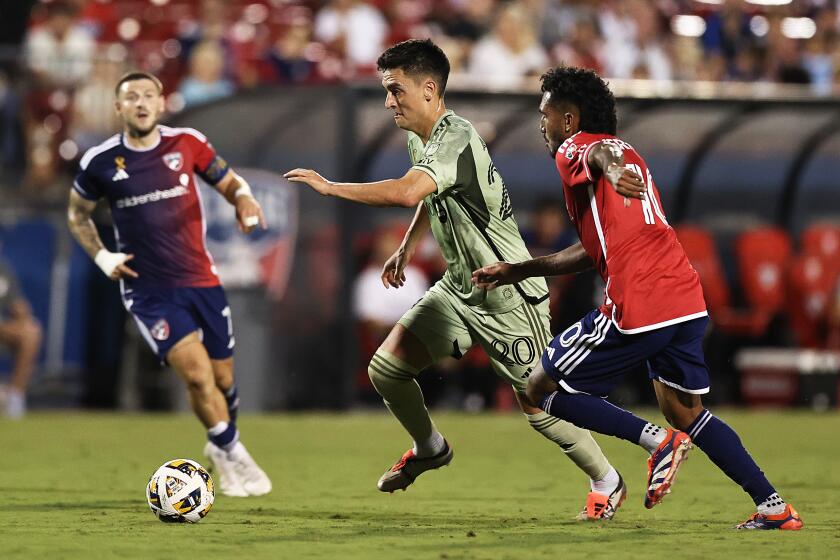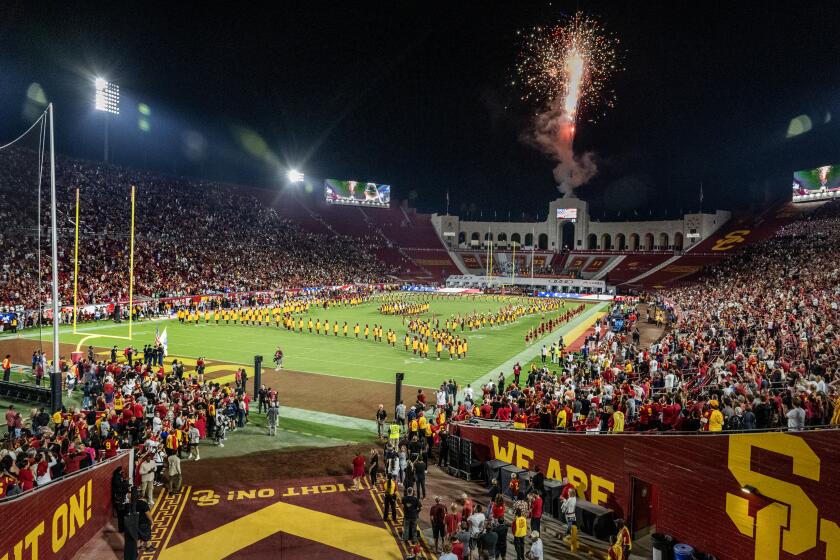The Comeback Game of the Year
The relief helicopter was waiting, ready to evacuate one of the last groups of employees from the Superdome after Hurricane Katrina. Over the course of a week, the stadium had turned from a storm refuge into an unforgettable site of suffering.
Nolan Ledoux, who since 1978 has worked in the bowels of the building as an operating engineer, made his way to the chopper. In one hand was his set of master keys to the stadium; in the other, his Superdome identification card. A security guard offered a tip: “Throw them away, because you won’t need them anymore.”
A year later, after the first phase of an unprecedented $185-million renovation of a stadium many people thought could not be salvaged, Ledoux still has his keys, his ID card and his job.
The 31-year-old Superdome reopens tonight before an international TV audience when the NFL’s New Orleans Saints play the Atlanta Falcons on “Monday Night Football.”
Billed as a triumphant moment for a devastated city, the game has taken on near-Super Bowl proportions, with performances by U2, Green Day and the Goo Goo Dolls; a kabuki drop -- a large curtain dropped from a hanging rod -- to honor 150 first responders who participated in relief efforts; and a coin toss by former President George H.W. Bush.
The Saints have issued about 1,000 media credentials to news outlets representing 11 countries.
“I’ve done three Super Bowls here, and this feels like a Super Bowl,” said Doug Thornton, regional vice president of SMG, the private management company that runs the Superdome. “The difference is, this one is for the locals.”
The typically hapless Saints haven’t played in the Superdome since Aug. 26 of last year, when they met the Baltimore Ravens in an exhibition game on the Friday before the storm. But they return seemingly reenergized. They are 2-0 this season after going 3-13 in 2005, when they played “home” games in Baton Rouge, San Antonio and New Jersey.
There was an upside to their struggles. The poor record granted them the second pick in the NFL player draft, and they used it on USC’s Heisman Trophy-winning running back Reggie Bush, a move that largely fueled the first season-ticket sellout in the team’s 39-year history.
A franchise that sold about 30,000 season tickets before Katrina sold 68,324 for this season.
“Until you visit here or spend time here, you really don’t understand what this team means to this region,” said Saints running back Deuce McAllister, who was raised in Mississippi and has relatives who live in the devastated Gulf Coast region. “When you’re born, it’s like you’re born with that black and gold in your blood.”
But not everyone agrees that rebuilding the football stadium should have been a top priority after the costliest natural disaster in U.S. history, one that left 80% of New Orleans underwater and displaced more than a million residents in the Gulf Coast region.
Critics point to the decimated areas that stretch for miles in every direction, street after street of wrecked houses and ravaged neighborhoods that might never be repaired. More than 1,500 people died in Louisiana as a result of the storm and flooding.
“I feel like there’s nothing to celebrate,” said Cheryl Jones, who was stranded for two days on Interstate 10 and two more in the Superdome before being evacuated to Houston. She now lives in Katy, Texas. “Once our community is up and running and 90% of the people are back at home, then we can have a celebration.”
Karenlynn Bell, who lost her home in the 9th Ward and spent a week in the Superdome during and after the storm, said she would not pay attention to the festivities either.
“I don’t want to set foot in there, even for a game. It’s more for the tourists, more for the people on the West Side,” she said, referring to the upper-class suburban neighborhoods largely spared from destruction. “The evacuees ... you don’t hear them excited.”
NFL Commissioner Roger Goodell said it was state officials who determined that the rehabilitation of the dome was a critical component in the rebuilding of the community.
“They believe it was a huge economic driver and a huge symbolic effort to be able to get that dome reopened and be operating,” he recently told reporters.
During the storm, the Superdome housed an estimated 10,000 people, and that number swelled to more than 30,000 with the subsequent flooding.
Although the stadium had food, drinking water and dim lighting thanks to emergency generators, neither the plumbing nor the air conditioning worked. Temperatures inside hovered near 100 degrees. Thousands of people gathered on the concrete ramps and concourses that encircled the stadium. Several days passed before buses arrived to evacuate them, mainly to Houston.
A National Guardsman was shot inside the dome, and six people died in and around the building, Superdome officials said. Four others either drowned or washed up at the site. One of the deaths was an apparent suicide, when someone leaped from an upper deck. Another was a drug overdose. Four were deemed by natural causes.
Thornton, who lived in the dome for 5 1/2 days during the storm and flooding, said he could understand that evacuees might be hesitant to return. His wife, Denise, who also lived in the stadium during that span, at first could not bring herself to step inside during the renovation.
“I understand how you could feel that way if you were in here,” Thornton said. “Because it was bad, the conditions were deplorable.
“But I would ask that person to look at how many lives were saved as a result of the dome being used. Think of the people who were shipped in from rooftops every day ... coming in here with nothing but the clothes on their back. Those people would have died in their attics or on their rooftops.”
When the storm passed and the flooding subsided, the future of the stadium was uncertain. Initial reports said it was beyond repair.
But by late September, a month after Katrina, construction consultants reported that, despite severe water damage, the building was structurally sound and repairs could be completed within 18 months.
Cleanup crews in masks and protective suits removed about 4,000 tons of debris, including dozens of pets that died, left behind to avoid overcrowding on evacuation buses.
The construction and repairs didn’t begin until March 1. That the stadium is event-ready is remarkable, though the renovation is not complete; the luxury suites and ballroom won’t be finished until next summer. But the rest of the Superdome is far better than it ever was.
There’s a new field, thousands of new seats, an expanded state-of-the-art scoreboard, a new sound system and brighter lighting. The largest and most important repair was a new roof at the cost of $32.5 million, replacing the one that was partly peeled off in the storm.
The renovation has cost $144 million and is expected to top out at $185 million.
About $114 million of that was allocated by the Federal Emergency Management Agency, which provided funds to cover uninsured losses to state property -- separate from funds used to reimburse individual homeowners. The Superdome Commission contributed $41 million, and $13 million came from the state. The NFL’s contribution of $15 million was for improvements to the stadium rather than repairs.
Thornton, overseeing the stadium reconstruction, said the job was a microcosm of the recovery efforts and a message that “the Superdome is back, and New Orleans is coming back.”
That might be so, but team owner Tom Benson has offered no assurances that the repairs and improvements to the Superdome will be enough to keep the Saints in New Orleans.
Before Katrina, he rankled local politicians and fans by complaining about terms of the team’s lease -- it expires in 2010 -- and talked about advances made by others interested in buying the team.
Still, Thornton said, the revival of the Superdome is a step in the right direction.
“I think what the NFL has given New Orleans is an opportunity to perform,” he said. “That’s really all we want.”
At the least, tonight will provide a welcome distraction.
“As silly as it is, and as irrelevant as it is to the long-term health of the city, to have something to cheer for and to have a visible sign of success is very useful for New Orleans,” said author Michael Lewis, who was raised in the city. “Someone has proven that you can succeed in New Orleans.”
As for Ledoux, he will work the day shift today, helping with the final game preparations. Then he’ll head home to Waggaman, La., about an hour west of New Orleans, and watch the game on television with a sense of pride.
“We’re not looking back,” Ledoux said. “This is all about looking forward.”
More to Read
Go beyond the scoreboard
Get the latest on L.A.'s teams in the daily Sports Report newsletter.
You may occasionally receive promotional content from the Los Angeles Times.











